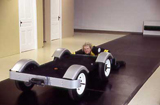Bruce Barber Interviews Rita
|
BB: Shudder (1998), another of your multidisciplinary performance installations, was performed at Ace Art in Winnipeg. This work involved several kinetic elements, including four performers, two vocalists, two video projections and a highly charged pre-recorded audiotape broadcast through two speakers that traveled the walls of the gallery. How do you determine the structure of a work such as this? How important is your preliminary research, the architectural space, and what role does collaboration with your performers play?
RM: The architectural space is crucial to the focus on the metaphor that drives the physical components of the work. Yes I do rehearse with the performers. I describe to them some of the ideas in the work and the structure of the performance. I suggest a vocabulary of possible gestures or interpretations and then we run through it together. We collaboratively discuss what worked and what didn’t and then try it again. I make the final decisions about what to include but it is very collaborative in its process. I trust and respect everyone I work with. They have brought so much to the work that it is never what I could do alone. I value the dialogue and the friendships that are part of the process. BB: You have consistently worked with a wide variety of media (audio, video and digital media), musical instruments and performance techniques and have for some time now been very interested in kinetic and robotic works. Your teaching of workshops at Banff, NSCAD and through CFAT (Centre for Art Tapes), ACAD and other institutions are now legendary. How important is technology for your work? RM: I became interested in electronics because I wanted to break apart my performances and give aspects of them to the performing objects. I felt that by fragmenting the gestures and activities within the performance I might be able to remove any redundant or ineffective elements. I love the freedom that technology allows. Time-based technology translates very complex experiences. I also love the challenge of acquiring technical skills. As an art student I studied printmaking and I still enjoy this type of complexity of multiple layers of content being experienced simultaneously in my installation and performance work. BB: Your work mixes humour and tragedy in a very interesting way. Do you walk a tightrope between these two emotional spaces? RM: Yes, I find that when I look back on my work it seems that it is all about sorrow, but it is often so goofy that that seems to temper the intensity. I find that there is always an emotional setting present in the music and writing of the sound components. For many years I have played drums in bands. There is always a great deal of passion or intensity involved in playing music and that allows an emotional perspective to enter the content of a song or performance /installation. I’m often embarrassed when I become too didactic in a work and so humour allows me to laugh at my own antics and hopefully gives the audience room to respond to the work critically or emotionally. BB: You have lived in several Canadian cities and in each place have found a community of collaborators and willing participants to engage with you in the construction of your work. How important is building a community practice for the continuation of your work as a multidisciplinary performance artist? RM: I have been very fortunate to have the support and assistance of my friends and colleagues in many cities and communities. I had tremendous support from the music communities I have had the pleasure of being a part of. I have collaborated with amazingly talented artists and musicians and I have benefited so much from all that they have given me. Because of the scale of my installation and performance works I could never have completed them without the help of my friends. I have also been fortunate to live in communities that are very respectful towards the diversity of practices and that kind of support has always given me the confidence to invest in my ideas. The best thing about In Bocca al Lupo was the people that I had the pleasure of working with. That has always been my favourite part of working. Every chance I get I want to send respect, gratitude and love to everyone who has helped me. BB: Rita, thanks for participating in this interview. |
  |
